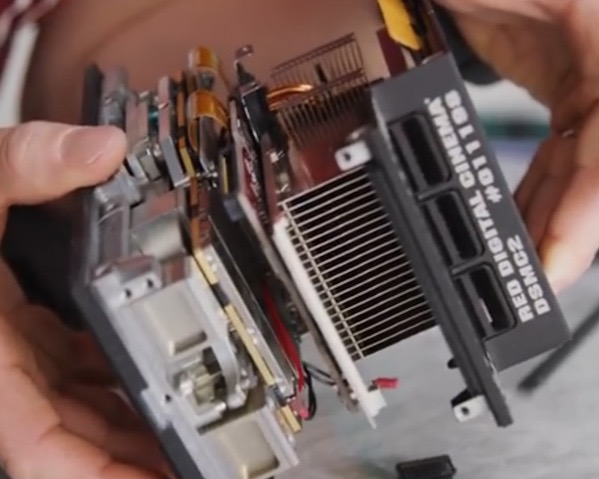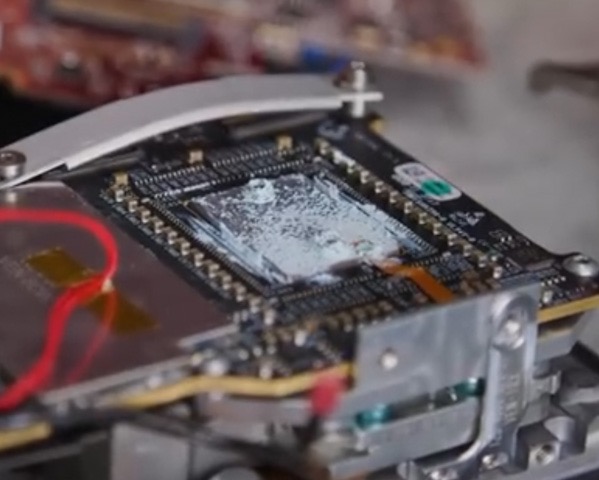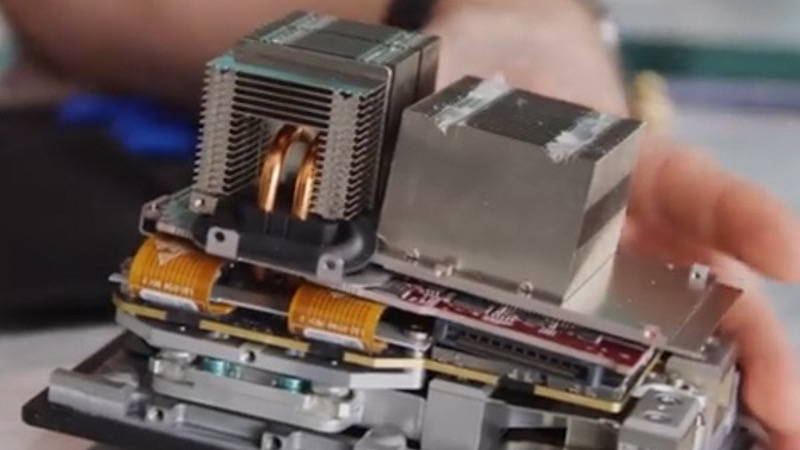Most people buy expensive cameras and use them rather than taking them apart, but Linus Tech Tips has a different approach. They decided that they would rather take the camera apart, with a view to converting it to water cooling. Why? Well, that’s perhaps like asking why climb Mount Everest: because it is there. The practicality (or desirability) of water-cooling an 8K camera aside, the teardown is rather interesting from an an engineering point of view. The RED HELIUM 8K costs about $25K, and most of us don’t often get a look inside equipment like this.
The video that we’ve placed below is, as you might expect, more about the horror of tearing the thing apart than the real details, but you do get some insight. There seem to be at least five different PCBS and a while mess of ribbon cables between them. A lot of the camera brains seems to be in the form of Kintex FPGA chips, some of the more powerful ones in the Xilinx lineup. At $1600 each, that’s probably a big chunk of the cost of the camera right there.

The current cooling system of the camera is also somewhat crazy looking, with multiple heat pipes pulling heat from the multiple PCBS, each holding large FPGA chips to a ducted radiator at the back. There’s a huge amount of thermal grease in there.
Perhaps this huge heat sink makes more sense than you might think at first, though: the RED camera turns off the fans while shooting to avoid noise, so the system has to absorb a lot of heat while shooting, then dissipate it afterwards quickly before it has to switch to silent running again.

There is also a rather odd-looking arrangement for cooling the sensor chip. It looks as though the heat sync works through a hole in the PCB, possibly with a Peltier or similar pulling heat from the back of the chip. Any more insight from this? Would any of those who are experts with this kind of system want to let us know what they see?
















$25k may seem a lot to those who grew up with access to sub-$1000 high resolution digital cameras but I’m old enough to recall when video cameras cost a bit more.
Back in 1981 I had to purchase an Ikegami ENG camera for a project. It was about £30,000 at the time. In 2019 values that’s £114,042.92 or USD143,572.20.
To add some perspective to the £30k cost, it was equivalent to five years wages at the time.
Agreed. I used to work with quite expensive equipment in the 80s, too. The question isn’t really about “what does it cost” but about “do we need it? What does it bring to the table?” Either the budget is there – or it isn’t.
(young/internet-)People today seem to think that everything has to be cheap just because. Instead of buying 10 cheap cameras that all don’t quite cut it, you could buy one that just works. Often enough the “higher” investment turns out to be the “best bargain”.
Yep, most of people on internet who are talking about video equipment are amateur and don’t understand anything about tech behind camera, lenses and other equipment. 25K$ for a camera isn’t much but because they believe they can do the same Job with a 100$ smartphone they will find this very expensive.
$25,000 is nothing. I used to work in Hollywood. One day I was cleaning up after a shoot and was moving the camera around. Offhandedly, I asked someone who is working with me” hey how much does this camera cost?” This person told me that I was holding a half a million dollars worth of equipment. That was an Arri camera. If it had been a Panavision camera, they said that those can go up to a million dollars. Needless to say, I took a little bit more care with that camera after that.
And now we know why movies are so expensive. :-j
It’s unlikely that production companies owned the gear they use, at least since the collapse of the major studio system. Camera rentals are more common and although very expensive, not THAT expensive and the cost vanishes when you start looking at promotion/distribution costs.
It’s also cheap compared to some of its competition on the market now, such as ARRI’s digital products or the likes of Sony VENICE.
I vote Linus Tech Tips most annoying, most unwanted YouTube ‘suggested’ channel.
It is infuriating, there is genuinely some interesting content–for example the teardowns, absurd attempts at repurposing server hardware for desktop use, occasional interesting product reviews–but the style of the channel is so over the top annoying as to make their videos all but unwatchable. Yet somehow they have the incredible viewership that makes the aforementioned interesting videos possible. Why? Is there no justice in the world?
It’s not for the common folk around HaD, but for actually “gammery” or normal common folk.
there is only so many times you can click 3 dots and not interested.. this channel gets suggested way to much!
Don’t they just pay for these ‘suggestions’?
Nothing is ever really free with Google.
Nope, it’s all algorithmic for them
I’ve never enjoyed anything I’ve come across or been linked from him… I just figured it was because I’m a cynical dick.
Linus Tech Tips is insufferable click-baity trash. Shouty, flaccid, empty and completely inconsequential.
When he brought in the second guy in this video, I thought I was watching a dumb and dumber sequel.
“heat sync”? – When you need to synchronise some heat?
It is something that a person don’t understand the technobabble that he is saying would use.
That and wrong upper/lower casing of scientific units shows the person have no clue of technical knowledge.
If a person can afford the camera, they can afford to replace it after seeing what’s inside of course.
If a person can afford to buy a house, they can afford to buy a second house to rent out. And anyone who owns two houses would obviously find it no problem to get a third. This is why everyone owns either no houses or an infinite number of houses.
The Audine project also cools its CCD through a hole in the PCB:
http://www.astrosurf.com/audine/English/index_en.htm
and I also cool my CCD through a hole in the PCB. So I’m guessing it’s not so unconventional.
The point of cooling the CCD is not to keep it from burning up, it’s to minimize thermal noise and/or keep the thermal noise constant. So I’m guessing that in a compact system like this, you’ll want as little thermal mass between the peltier and the sensor as possible, because you can only move so much energy before the hot side of the system is “saturated” and further cooling becomes impossible, when the fans are not running. Also a low thermal mass gives a more responsive cooling system.
Linus Tech Tips is utterly annoying. He made a review of the mentioned Red Camera, which boils down to: “I find it to be too expensive because I have no clue”. These guys point that out quite well: https://www.youtube.com/watch?v=fuSJ5k1orBk
Indeed — LTT is/was awful. Something to take care to avoid in the future. Why drag “Linus” into the mess.
Ugh… It boggles the mind how such a clueless and annoying moron can be so famous…
Or is everyone watching him for shits and giggles?!
I hate his screwdriver style. He comes in at an angle, like he’s going to dig in under and gouge the screws out. Would like to see a bit more finesse.
+1
Even worse is that YouTube constantly recommends his videos to me . The only thing his channel has in common with the signal path, EEVblog and the like is, that it’s more or less about “electronics”.
YT algorithms in general sadly seem to be optimized for mainstream watchers…
whoa, I can understand annoying, but clueless and moron is unfair.
I must admit that I cringe every time they pick up a tool (files especially),
but their knowledge and consumer advocacy on PCs and consumer electronics are well done and fair.
Like that is rocket science. Clueless and moronic seems pretty apt. A click-bait tech channel picking the lowest of the low hanging fruit. Typical useless gits who confuse money and gear for skills and knowledge.
They fixed the click bait titles and thumbnails. This was setup in such a way as to support their business because YT’s algorithms prioritized this type of textual output. His audience complained and he literally retroactively adjusted for removing that type of identification.
ISTR that early CCD broadcast cameras in the late 80s/early 90s used Peltier devices to keep the CCDs cool (and thus reduce thermally introduced noise) – so it makes sense for that to be a technique still in use?
And if people think a US$25k camera shooting 8K is expensive, wait until they see the cost of a decent 8K broadcast lens…
Can we have PhaseOne next? :}
Just gonna be that guy as a journalist you have the duty to report the news accurately. In this article you major glaw was not crediting Linus for this teardown. Instead you used it and made it sound like your own
My friend that is plagiarism
First sentence:
“Most people buy expensive cameras and use them rather than taking them apart, but Linus Tech Tips has a different approach”
Who did the teardown? “Linus Tech Tips”
ID10t error.
Instead of wasting time with that clueless tectip guy inbetween those annoying advertisements, I much prefer to watch a real cool camera, torn down by a really cool guy and how it improves signal to noise ratio.
I also appreciate that Mike has real content instead of hiding the lack of real content under senseless spectacularity.
https://www.youtube.com/watch?v=JbCM3f0ofW4
Tearing Down A $25K 8K Video Camera and photographing it with a camera from the check-out lane at Walmart. Some of the lousiest, poor depth-of-field images I’ve ever seen.
Oh, and what exactly is a “heat sync”???
A “heat sink” that doesn’t march to the beat of a different drummer.
A technobabble parroted by a person that doesn’t understand words he is using. i.e. a wannabe pretender
It is not hard to know what the real word means in the context of Sink vs Source.
A resonant loop heat pipe of course. ;)
Can’t escape the LTT suggestions on youtube and now it’s copypaste LTT time on hackaday? Alright, how much are they paying you?
Indeed. This level of click-bait incompetence does not belong on HaD.
Hey what’s up guys ? You know where is the internal battery on this DSMC2 ? which card ? Thanks ;)
sad to see all the linus hate here. His content is just not for everybody and that’s perfectly fine. I suspect people will be more interested in wendell from level1techs.
His content/click-bait is devoid of anything consequential and aimed at the lowest common denominator. A ad revenue scheme with no subtsance at all. It is internet cancer
I know, right? All he’s doing is making videos about electronics in an irreverent style. Haters just gonna hate, I guess.. :/
If it was only the style, I would just ignore him. That is just about taste. But the few videos I actually looked at where full of misleading or just wrong information. And his electronics skills are negligible and he also seems to produce a lot of videos of which I saw similar videos before on smaller channels, which makes me thinks he is stealing his “original” ideas from others. The average dumb consumer or script kiddie will not notice it. He is not informing he is selling.
It think the biggest problem there is the assumption that he should know stuff about electronics to the level of someone like strangeparts. linustechtips is a pc/computers channel and not electronics. He has staff to fill his gaps in knowledge, I think you guys need to watch a video with Anthony because he has a more suitable style for ya.
The problem is that this post was made on hackaday which just isn’t the right place for his content (possibly only because of an elitist/snobbish attitude of ha) and the post was made in really bad fashion with mistakes like: “heat sync” and no attribution.
Your comment about script kiddies is just misplaced.
You’ll need a degree wheel, to properly sync the heat waves!
Unfortunately, professional film (and video) equipment lives at the intersection of high required precision, demanding users, and a tiny, tiny, tiny user base.
That’s what really drives the cost. I have an old 35mm Mitchell film camera. Mitchell, for those not in the biz, used to be *the* camera company in Hollywood. There probably wasn’t a ‘serious’ film shot between the 30’s and the 70’s that didn’t use Mitchell.
My camera was one of the last made, probably around 1974, and has serial number 1419.
There were other models, of course, but overall Mitchell probably produced less than 2500 cameras in the course of 45 years, and those years, it should be noted, bracketed the ‘Golden Age’ of Hollywood.
Canon probably makes 2500 cameras before lunch.
Selling 50 cameras a year means that ‘professional’ equipment is almost custom, and that in turn means that it’s really difficult to achieve any economies of scale.
The working bits of a motion picture camera are comparable in precision to professional still cameras from Nikon or Canon (in fact, many of Panavision’s specialty lenses were Nikkor or Canon lenses rehoused in more robust mounts), but
Nikon or Canon can spread their cost through millions of units, whereas Arri or Panavision has to recoup all their design, manufacturing and marketing costs over production runs in the dozens.
I used to work at Laika and Mitchell’s were used in the stop motion industry for a very long time. Stepper motors were attached to the camera to advance them one frame at a time. Laika has the largest single collection of Mitchells, I cant remember how many but it filled a container.
Why include this cheap ad revenue clickbait on HaD? It is devoid of substance or insight and it is of no use what so ever. Also not a hack!
Don’t support grifters like this please. I is beneath this site.
If people here cant tell you desperately hate Linus Tech Tips, you haven’t said it enough
It’s not desperation. it is passion. I passionally hate fluff like that.
You is beneath this site indeed. :)
Maybe it was the same team that designed their cell-phone entrant. I suspect RED will be dead in 10 years.